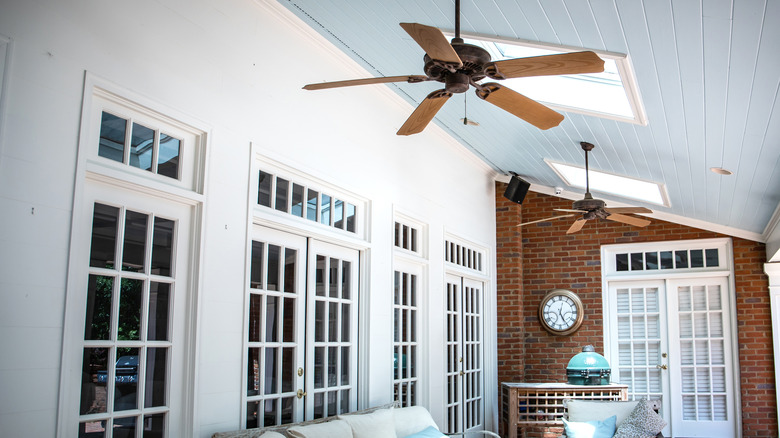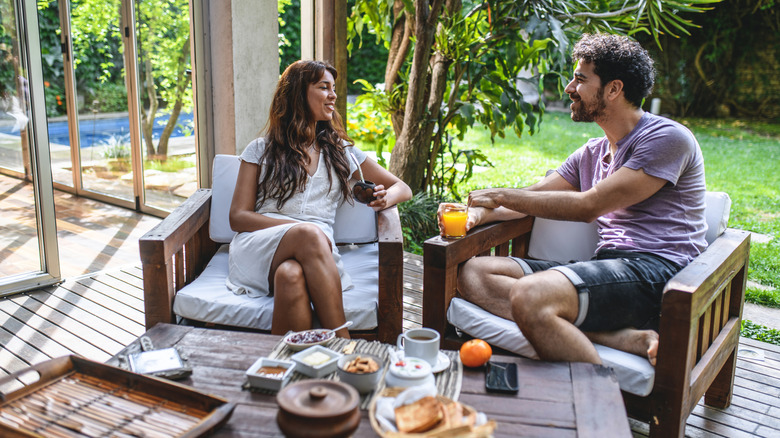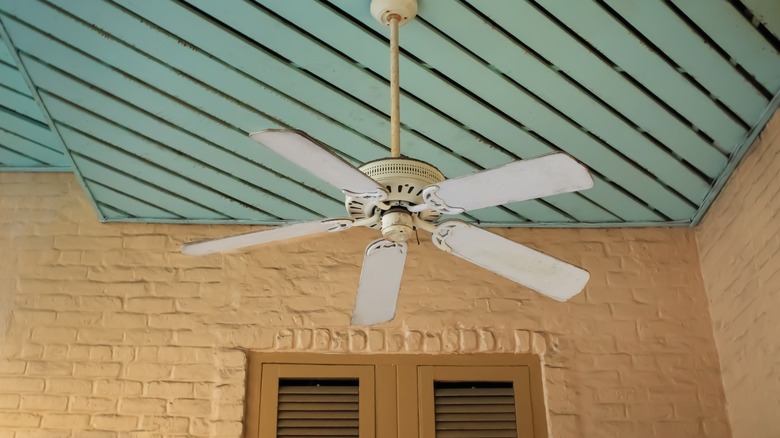An Outdoor Patio Fan Can Help Keep You Cool But There Is A Limit
You've put the time and effort into building the perfect summer patio, and not only is it comfortable, it has plenty of shade. That should be enough to keep you cool during those hot summer days, right? Unfortunately, the sweltering heat can take its toll on your body — even if you're sitting in a comfortable, shaded area.
To help combat this heat, many people place both large and small portable fans on their patios when sitting outside during hot summer days. Some homeowners even have ceiling fans on their patios. A well-placed patio fan is not to be underestimated, and can make your patio a much more comfortable place to spend time in the summer. Placing these fans on your patio can keep you cool through a process known as convection, during which warm air is replaced by the cool air the fan blows your way. Fans also help remove sweat from your skin, helping accelerate natural processes that reduce your body's temperature.
However, while both portable fans and ceiling fans can help keep you cool and make your patio more comfortable, you should be aware that they have their limits. During the hottest summer days, an outdoor patio fan may not help as much as you would hope. Fans will only marginally increase your comfort since they don't blow cold air, but simply move air around. If it's particularly dry or if the temperature is especially high, they may even do more harm than good.
Here's what goes wrong with patio fans
Sweating can naturally help cool you down, but your sweat won't evaporate as quickly in humid conditions. Fans can make your sweat evaporate faster, helping your body do its own job of keeping you cool in humidity. Up to around 90 degrees Fahrenheit, and with humidity present, a patio fan will help cool you down to some extent.
However, if it's extra dry or the temperature is even higher than this, fans won't do much good and may even make things worse. In dry heat, a fan won't offer the benefit of helping with sweat evaporation since your body won't be producing much sweat anyway — it will try to hold onto as much water as it can. Instead of helping with sweat evaporation, the fan will simply be blowing hot air straight onto your skin. This will cause your body to become hotter and more dehydrated, rather than keeping it cool.
To get the most from a portable fan or ceiling fan on your patio, you'll need to use it wisely. Remember not to expect too much when the temperature gets too high — avoid using it in extreme heat or if it's extra dry. Otherwise, you may regret it.
More tips for using an outdoor patio fan
If using portable fans on your patio, consider directing them from a cooler spot. If there's a shaded area or pond close to your patio that tends to stay a bit cooler, have the fan facing towards your patio, pulling in air from that direction. You can also place a fan in an open window, pushing cold air to your patio from inside your home. Remember that the portable fan will pull in the air that's behind it, so the colder that air is, the better.
In addition to using portable fans on your patio, consider installing an outdoor ceiling fan if your patio has a ceiling and the space allows for it. When using a ceiling fan, keep it on the highest speed to ensure great airflow. This will also offer the added benefit of repelling insects from the area too since they won't be able to navigate the air as well.
You should also know which direction your ceiling fan should spin in the summer months. Your fan should spin counterclockwise in the summer – this creates a downdraft and provides a "wind chill" effect that will help you feel cooler. Finally, make sure to clean your fan's blades thoroughly. Keep your ceiling fan dust-free to ensure it won't have to work harder than necessary and will cool your space efficiently. When choosing a patio fan, also ensure you get one that's the perfect size for your space.


